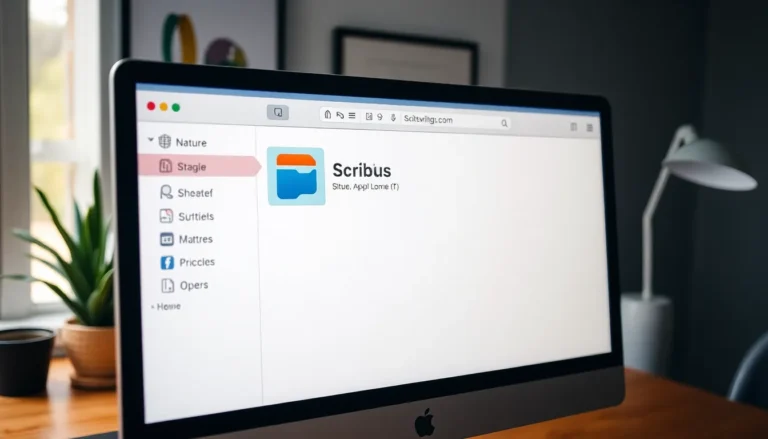In a world where everyone seems glued to their iPhones, the demand for killer iOS apps is skyrocketing. Developers are not just coding; they’re crafting experiences that can make or break a user’s day. But how do they do it? Enter the realm of iOS app development software, the unsung hero behind every swipe and tap.
Table of Contents
ToggleOverview of iOS App Development Software
iOS app development software encompasses tools and platforms that streamline the creation of applications for Apple’s iOS ecosystem. These resources are essential for developing robust, user-friendly mobile apps.
What Is iOS App Development Software?
iOS app development software refers to programs that assist developers in building applications specifically for Apple’s iOS devices. Included in this category are integrated development environments (IDEs) like Xcode, which facilitate coding, testing, and debugging. Other frameworks, such as SwiftUI and UIKit, offer pre-built components that enhance design and functionality. These tools cater to a range of development needs, from simple apps to complex software solutions.
Importance of iOS App Development Software
iOS app development software plays a critical role in creating high-quality mobile applications. Developers rely on these tools to ensure consistency and performance across various iOS devices. Utilizing well-established software increases efficiency, enabling faster course corrections during development. Additionally, robust app-building tools come equipped with built-in testing features that improve potential user experiences. The integration of analytics tools within these platforms also aids in assessing app performance post-launch and provides insights for future updates.
Popular iOS App Development Tools

Numerous tools assist in developing iOS applications. Each tool has unique features and benefits.
Xcode
Xcode serves as the primary IDE for iOS app development. This tool provides a comprehensive suite of features, including code editing, debugging, and performance testing. Developers leverage its intuitive interface for streamlined project management. Swift and Objective-C programming languages are fully supported. Xcode integrates with various frameworks like UIKit and SwiftUI, enhancing the development process. Continuous integration features enable easy updates and changes, making collaboration seamless among teams.
Appcelerator
Appcelerator focuses on cross-platform mobile application development. This tool enables developers to create apps for iOS and Android using a single codebase. Titanium SDK supports JavaScript, reducing development time significantly. Its built-in analytics allow tracking app performance and user engagement. Appcelerator simplifies the maintenance of apps across different platforms, ensuring consistency in user experience. Access to a wide array of APIs enhances functionality within applications.
Flutter
Flutter stands out as a powerful UI toolkit for building natively compiled applications. This tool supports development for mobile, web, and desktop platforms. Developers use Dart programming language for its versatility and efficiency. Hot reload feature allows instant UI changes without losing the app’s state. Flutter’s rich set of widgets provides customization, ensuring a unique look for each app. This framework promotes code reuse, which improves productivity and reduces time spent on development.
Key Features to Look For
Selecting the right iOS app development software involves numerous factors that can significantly affect the development process and the final product. Understanding key features ensures developers choose tools that enhance productivity and improve user experience.
User Interface Design
User interface design remains crucial for engaging users. Software that offers intuitive design tools simplifies the app-building process. Integrated design elements can speed up the creation of visually appealing interfaces. Effective iOS development software supports design previews, which help developers visualize changes instantly. Responsive layouts allow developers to tailor the app for different screen sizes, ensuring optimal usability across iOS devices.
Code Editing and Debugging
Code editing features enhance development efficiency. A robust code editor provides syntax highlighting, code completion, and error detection. Such tools minimize typos and improve code quality. Debugging capabilities facilitate the identification and resolution of issues early in the development cycle. Integrated simulators enable testing directly within the IDE, allowing developers to troubleshoot without switching contexts, ultimately streamlining the workflow.
Performance and Testing Tools
Performance analysis is essential for launching successful apps. Quality software includes built-in performance monitoring tools. These allow developers to assess speed and responsiveness during development. Testing features enable continuous integration, supporting automated testing processes that enhance reliability. When software provides real-time analytics, it contributes to informed decisions that improve app functionality after launch.
Choosing the Right Software for Your Needs
Selecting the right iOS app development software requires thoughtful consideration of several factors. Key aspects include the developer’s skill level and financial resources.
Assessing Your Skill Level
Assessing skill levels plays a crucial role in choosing software. Beginners often benefit from user-friendly interfaces and integrated tutorials, making tools like Appcelerator and Flutter appealing. Intermediate developers may prefer robust IDEs like Xcode, which provide advanced debugging features. Experienced developers often seek flexibility, favoring frameworks that allow for extensive customization. Examining available resources helps ensure the software matches the specific expertise of the developer.
Consideration of Budget and Resources
Budget constraints can significantly influence software choice. Cost-effective options exist for various budgets, with free tools like Xcode providing significant capabilities. Paid solutions offer additional features, but should align with project goals and resource availability. Resource allocation affects decisions; investing in high-quality tools often leads to better apps. Weighing the cost of software against potential app revenue is essential for informed decision-making.
Choosing the right iOS app development software is vital for creating successful applications that meet user expectations. With a variety of tools available developers can find options that suit their skill levels and project requirements. Whether utilizing Xcode for its comprehensive features or exploring cross-platform solutions like Appcelerator and Flutter the focus should always remain on enhancing user experience and app performance. By carefully evaluating software capabilities against project goals developers can make informed choices that lead to impactful iOS applications. Ultimately investing in the right tools can pave the way for innovative solutions in the ever-evolving mobile landscape.









